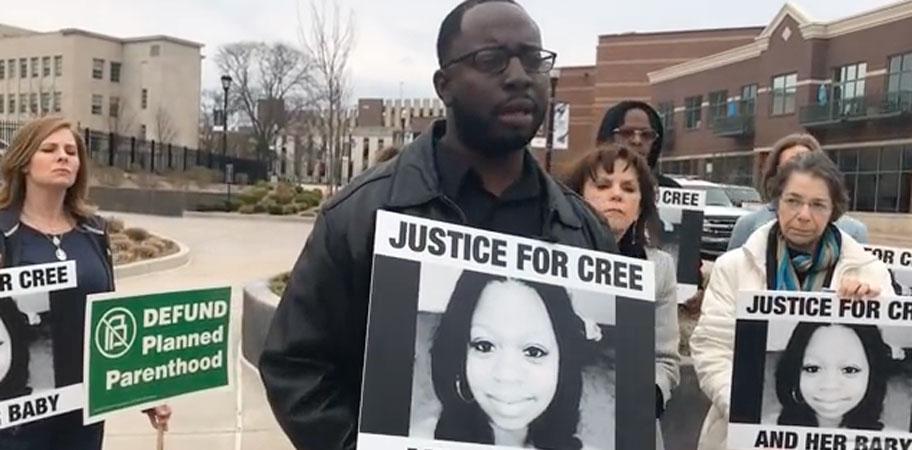This coming 4th of July will mark one year since the death of Cree Erwin-Sheppard, a 24-year-old mother from Battle Creek, Michigan, who suffered a painful death after a botched abortion. Suspicions about hospital negligence and lack of accountability from Planned Parenthood have been raised since the release of an autopsy report given to the Kalamazoo Gazette, along with new information about Cree’s death obtained by her brother, Tyler Sheppard.
On Thursday, April 13, Tyler Sheppard, along with Cree’s other brothers, David Coleman and Ashton Erwin, publicly protested the mishandling of their sister’s death. During the protest, Sheppard shared the medical record of Cree’s emergency visit after her botched abortion. An ultrasound done at the Bronson Battle Creek Hospital on July 2 showed “the presence of a clot and/or retained products of conception.” The emergency record also stated that”the patient’s symptoms and work-up results were consistent with an incomplete miscarriage and pelvic pain.”
Cree went to the emergency room at Bronson Battle Creek Hospital on the night of July 2, vomiting and in extreme pain. After the ultrasound, she was given morphine for the pain and anti-nausea meds. She was discharged with a prescription for pain and anti-nausea meds. Erwin-Sheppard was instructed to take the meds and follow up with Planned Parenthood or her doctor after the Fourth of July weekend.
Tyler Sheppard, along with others, is questioning why E.R. doctors would release Cree after the ultrasound showed a “clot and/or retained products of conception.” According to Sheppard, the hospital pharmacy was closed when she was discharged. Erwin-Sheppard’s hospital discharge papers state that she was released at 12:35 a.m. on the morning of July 3. Tyler told Michigan Live News:
They saw baby parts still inside of my sister and they still sent her home. I want to know what happened…. They sent her home and the next day she died. I want to know why my sister’s life wasn’t good enough to save.
In addition to the uncertainty surrounding Cree’s hospital release are questions about her death certificate. Erwin-Sheppard’s death was a result of blood clots in the lungs and uterus, a uterine perforation from a vacuum aspiration abortion, and the placement of an IUD. The death was labeled an “accident” and “methadone use” was a contributing factor.
Lynn Mills, a pro-life activist in Michigan who has been working on Erwin-Sheppard’s case and with Erwin-Sheppard’s family, told Live Action News that the methadone in Cree’s system was minuscule and was likely used in desperation for pain management. Tyler Sheppard agrees with that statement and told Michigan Live that his sister was not a user of illicit drugs. In Box 41c of the death certificate, where the medical examiner is asked to describe how the injury occurred, the written answer is “Use of unprescribed drugs.” Troy Newman, president of Operation Rescue, commented, “That answer is completely ridiculous. Drugs don’t cause the uterus to put a hole in itself. It’s hard to believe this is the best the medical examiner could come up with after eight months.”
Pro-life activist Lynn Mills believes there is an attempt underway to highlight the minuscule amount of methadone in Cree’s system to shift focus off the botched abortion at Planned Parenthood and the negligence of Battle Creek Hospital. Operation Rescue was able to obtain an unfilled prescription slip that was provided to Erwin-Sheppard by abortionist Laura Castleman on June 30, 2016, the day of her abortion. Although Planned Parenthood has not released the name of abortionist who performed Cree’s procedure, pro-life investigators are connecting it to Castleman.
Lynn Mills told Michigan Live News, “I will not accept Cree Erwin’s death as collateral damage to the abortion industry.” Mills believes that justice for Cree would include the abortionist losing her license, and on a larger scale, Planned Parenthood being shut down. Abortionists have lost their licenses when their crimes against women are made public.
Mills encourages pro-life activists to get involved when they see suspicious activity at abortion facilities. If you see an ambulance taking girls out after an abortion, tell someone in your city who will do something about it. The Freedom of Information Act allows for citizens to research and request information regarding the records of abortionists. If you know an abortionist who has botched procedures or has a bad record, Mills states the importance of getting that information out to a community. Women seeking abortions sign papers regarding risks, but many aren’t fully comprehending the severity some of those risks hold. In addition, many are unaware of the history of the abortionist whose care they seek out.
Cree’s death was a tragedy, as was the death of her preborn child. Many questions remain, and I’m grateful that pro-life activists are working to answer them. My heart is with Tyler Sheppard, Cree’s mother Tanya Hall, and the rest of the family as they continue to grieve the loss of their loved one.








